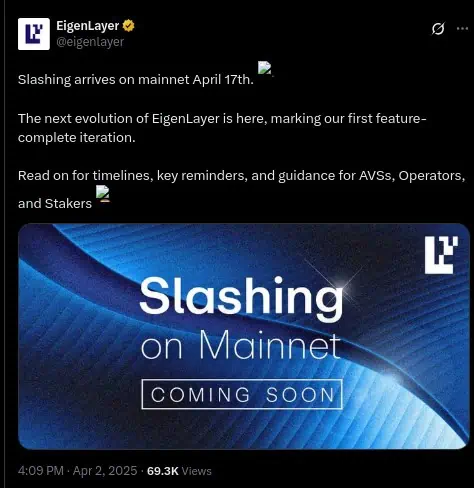
EigenLayer will implement the Slashing mechanism this month, marking a turning point in Ethereum security.
The developers of EigenLayer, an innovative protocol within the Ethereum ecosystem, have announced the implementation of a slashing mechanism for restakers, which will be implemented starting April 17.
In a recent post, the developers said this move represents a crucial step toward strengthening the network's security and integrity, as well as solidifying the restaking model EigenLayer has been developing.
Slashing is a penalty mechanism applied to blockchain network participants who fail to comply with established rules or who act maliciously. In the context of EigenLayer, this means that restakers who fail to meet the conditions set by Actively Validated Services (AVS) could face the loss of a portion of their staked funds.
To ensure a smooth and secure transition, EigenLayer developers have arranged for this mechanism to be thoroughly tested on the Ethereum testnets, Holesky, Sepolia, and Hoodi, before being implemented on the mainnet.
Tests in Sepolia and Hoodi: Preparing the Ground for Slashing
Before its implementation on the Ethereum mainnet, EigenLayer's slashing mechanism is undergoing rigorous testing on Ethereum testnets, which replicate mainnet conditions but allow developers to experiment and debug the code without putting real funds at risk.
Testing at Holesky began on April 2, while testing at Sepolia and Hoodi will begin in the coming days.

These tests are crucial for identifying and correcting potential bugs or vulnerabilities in the slashing code. Developers can simulate different scenarios of malicious behavior or negligence on the part of restorers and observe how the system reacts. This allows them to fine-tune the slashing parameters to ensure it is effective in deterring misconduct, while also not being overly punitive to network participants.
BUY ETHEREUMAdditionally, developers can analyze how it affects transaction speed, resource consumption, and network stability, helping them optimize their slashing implementation to minimize any negative impact on the user experience.
On the other hand, Tomorrow, April 7th, the Protocol Council is expected to schedule the transaction for the slashing update to go live on the mainnet after 10 days, on April 17th..
The Importance of Slashing for Ethereum Security
Slashing is a fundamental tool for maintaining the integrity and security of blockchain networks that use proof-of-stake consensus mechanisms (proof-of-stake). Its importance lies in the fact that it discourages malicious and negligent behavior on the part of validators, who are responsible for keeping the network running.
The slashing protocol is a security measure that guarantees the integrity of the blockchain. By penalizing nodes that act against the network's best interests, it adds a layer of trust and security that benefits all users. It ensures that only honest and competent participants have power in the network, reducing the risk of attacks and manipulation.
With its implementation, EigenLayer is expected to significantly strengthen Ethereum's resilience to various types of attacks, while opening the door to innovative new applications and services. The developers said the launch of this mechanism "is a major step forward for the EigenLayer protocol because it enables a free market where operators can earn rewards for their work and AVs can launch verifiable services."
LINK CARD AND EARNHow Slashing will be implemented in EigenLayer
EigenLayer has designed a slashing implementation process that seeks to balance security with network participation and stability. Thus, The adoption of slashing on the mainnet will not be immediate or mandatory for all participants.Node operators and restakers will be able to voluntarily opt in to the slashing system. This gradual transition allows users to familiarize themselves with the new system and assess the risks and benefits before fully committing.
If operators fail to meet the established conditions, the AVS may penalize them. If the operator successfully executes the service, the AVS may reward the operator's performance and incentivize specific activities. In addition, a 14-day waiting period has been established for all staking withdrawals after they have been placed on hold. This operating structure will allow the AVS to properly evaluate and slash pending withdrawals, if necessary. they said the developers.
Therefore, as part of the design for incorporating this system into the network, EigenLayer aims to make the transition as minimally disruptive as possible for restakers. Therefore, it designed this process to be gradual and voluntary.
EigenLayer currently has over 30 active AVs on its mainnet, with over 100 expected to be added and in development. While the transition may present challenges for some restorers, the long-term benefits for the network and its participants are undeniable. With extensive testing, a gradual rollout, and clear communication, EigenLayer is paving the way for a future where security and innovation can coexist harmoniously in the Ethereum ecosystem.
Investing in cryptoassets is not fully regulated, may not be suitable for retail investors due to high volatility and there is a risk of losing all invested amounts.



